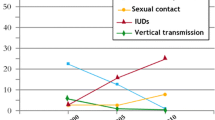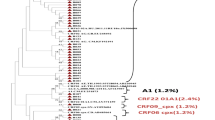Summary
Introduction
The first case of human immunodeficiency virus type 2 (HIV-2) seropositivity in Austria was confirmed in 1993 in a dually human immunodeficiency virus type 1 (HIV-1)- and HIV-2-infected patient from Ghana, who died in 2001. Before this investigation, no further HIV-2 infection was published.
Methods
The aim of this study was to describe HIV-2 epidemiology in Austria, using serological and molecular techniques, and to perform a sequence analysis of the circulating viral strains.
Results
Six additional cases of HIV-2 were identified from 2000 to 2009. All patients originated from high-prevalence areas. In one patient, the HIV-2 infection was revealed 11 years after initial HIV-1 diagnosis, and further analysis confirmed a dual infection.
Conclusion
The HIV-2 epidemic has its epicentre in West Africa, but sociocultural issues, especially migration, are contributing to the low but continuous worldwide spread of HIV-2. Diagnosis of HIV-2 implies a different therapeutical management to avoid treatment failure and clinical progression. Differential diagnosis of HIV-1 and HIV-2 is complicated due to antibody cross-reactivity, and paradoxical findings (e.g. declining CD4 cell count despite HIV-1 suppression) may require careful reassessment, especially in patients from endemic countries.
Zusammenfassung
Einleitung
Die erste HIV-2 Infektion in Österreich wurde 1993 bei einem HIV-1 und HIV-2 koinfizierten Patienten aus Ghana beschrieben. Bisher wurden keine weiteren Arbeiten über HIV-2 Infektionen in Österreich publiziert.
Methodik
Ziel dieser Studie war es durch Anwendung serologischer und molekularer Techniken eine erste epidemiologische Erfassung von HIV-2 in Österreich durchzuführen und mittels Sequenzanalyse die zirkulierenden HIV-2 Stämme zu charakterisieren.
Ergebnisse
Im Zeitraum 2000–2009 sind in Österreich sechs HIV-2 Infektionen bei Patienten aus hochendemischen Ländern diagnostiziert worden. In einem Fall, wurde die HIV-2 Infektion erst 11 Jahre nach einer initialen HIV-1 Diagnose erkannt, und weitere Analysen bestätigten dabei das Vorliegen einer HIV-1/HIV-2 Koinfektion.
Schlussfolgerung
Die HIV-2 Epidemie konzentriert sich primär auf westafrikanische Länder, wobei soziokulturelle Faktoren wie Migration zu einer langsamen aber kontinuierlichen weltweiten Verbreitung beitragen. Eine HIV-2 Infektion bedingt eine spezifische antiretrovirale Therapie, da nicht alle HIV-1 Medikamente auch bei HIV-2 wirksam sind. Die HIV-1/HIV-2 Differentialdiagnose wird durch kreuzreagierende Antikörper erschwert und paradoxe Resultate (z. B. sinkende CD4-Zellzahl trotz HIV-1 viraler Suppression) sollten insbesondere bei Patienten aus Hochprävalenz-Regionen zu einer Neuevaluierung führen.

Similar content being viewed by others
References
Clavel F, Guétard D, Brun-Vézinet F, et al. Isolation of a new human retrovirus from West African patients with AIDS. Science. 1986;233:343–6.
Barin F, Cazein F, Lot F, et al. Prevalence of HIV-2 and HIV-1 group O infections among new diagnoses in France: 2003–2006. AIDS. 2007;21:2351–3.
Soriano V, Gomes P, Heneine W, et al. Human immunodeficiency virus type 2 (HIV-2) in Portugal: clinical spectrum, circulating subtypes, virus isolation, and plasma viral load. J Med Virol. 2000;61:111–6.
Dougan S, Patel B, Tosswill JH, Sinka K. Diagnoses of HIV-1 and HIV-2 in England, Wales, and Northern Ireland associated with west Africa. Sex Transm Infect. 2005;81:338–41.
Damond F, Worobey M, Campa P, et al. Identification of a highly divergent HIV type 2 and proposal for a change in HIV type 2 classification. AIDS Res Hum Retroviruses. 2004;6:666–72.
Alabi AS, Jaffar S, Ariyoshi K, et al. Plasma viral load, CD4 cell percentage, HLA and survival of HIV-1, HIV-2, and dually infected Gambian patients. AIDS. 2003;17:1513–20.
Berry N, Ariyoshi K, Jaffar S, et al. Low peripheral blood viral HIV-2 RNA in individuals with high CD4 percentage differentiates HIV-2 from HIV-1 infection. J Hum Virol. 1998;1:457–68.
Kanki PJ, Travers KU, M’Boup S, et al. Slower heterosexual spread of HIV-2 than HIV-1. Lancet. 1994;343:943–6.
De Silva TI, Peng Y, Ledigdowicz A, et al. Correlates of T-cell-mediated viral control and phenotype of CD8(+) T cells in HIV-2, a naturally contained human retroviral infection. Blood. 2013;121(21):4330–9.
Poulsen AG, Aaby P, Larsen O, et al. 9-year HIV-2-associated mortality in an urban community in Bissau, west Africa. Lancet. 1997;349:911–4.
Leligdowicz A, Rowland-Jones S. Tenets of protection from progression to AIDS: lessons from the immune responses to HIV-2 infection. Expert Rev Vaccines. 2008;7:319–31.
Witvrouw M, Pannecouque C, Switzer WM, Folks TM, De Clercq E, Heneine W. Susceptibility of HIV-2, SIV and SHIV to various anti-HIV-1 compounds: implications for treatment and postexposure prophylaxis. Antivir Ther. 2004;9:57–65.
Möst J, Spötl L, Sarcletti M, Vogetseder W, Dierich MP, Zangerle R. Differences in heterosexual transmission of HIV-1 and HIV-2. Lancet. 1994;344:1572–3.
Tamura K, Dudley J, Nei M, Kumar S. MEGA4: Molecular Evolutionary Genetics Analysis (MEGA) software version 4.0. Mol Biol Evol. 2007;24:1596–9.
Saitou N, Nei M. The neighbor-joining method: a new method for reconstructing phylogenetic trees. Mol Biol Evol. 1987;4:406–25.
Felsenstein J. Confidence limits on phylogenies: an approach using the bootstrap. Evolution Int J org Evolution. 1985;39:783–91.
Tamura K, Nei M, Kumar S. Prospects for inferring very large phylogenies by using the neighbor-joining method. Proc Natl Acad Sci U S A. 2004;101:11030–5.
Damond F, Benard A, Ruelle J, et al. Quality control assessment of human immunodeficiency virus type 2 (HIV-2) viral load quantification assays: results from an international collaboration on HIV-2 infection in 2006. J Clin Microb. 2008;46:2088–91.
Torian L, Eavey JJ, Punsalang AP, et al. HIV type 2 in New York City, 2000–2008. Clin Infect Dis. 2010;51:1334–42.
Günthard HF, Huber M, Kuster H, et al. HIV-1 superinfection in an HIV-2 infected woman with subsequent control of HIV-1 plasma viremia. Clin Infect Dis. 2009;48:117–20.
Author information
Authors and Affiliations
Corresponding author
Rights and permissions
About this article
Cite this article
Taylor, N., Kern, J., Prammer, W. et al. Human immunodeficiency virus type 2 infections in Austria. Wien Klin Wochenschr 126, 212–216 (2014). https://doi.org/10.1007/s00508-013-0493-1
Received:
Accepted:
Published:
Issue Date:
DOI: https://doi.org/10.1007/s00508-013-0493-1




